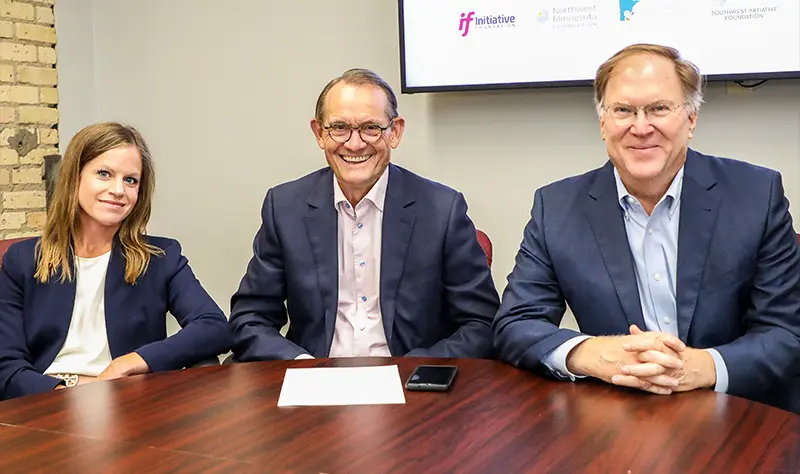Bob Kill, Enterprise Minnesota’s president and CEO, recently sat down with Jim Seifert and Natolie Hochhausen, two prominent legal experts, to get insights about new legislation and what manufacturers can do to prepare. Both are shareholders at Fafinski Mark & Johnson (FMJ), an Eden Prairie-based law firm.

Kill: Minnesota businesses are grappling with how to navigate a number of new laws that address paid leave, legal cannabis, and non-compete agreements — all significant changes to the way they currently do business. Let’s start with a thumbnail description of the paid leave requirements. Employers need to understand that they are dealing with two different laws here, right?
Hochhausen: Yes. There’s the paid family and medical leave insurance program that will be set up and administered by the state. The payments will typically cover between 55% and 90% of an employee’s wages during a leave of absence for a qualifying reason. The reasons that qualify under the program largely mirror the federal Family and Medical Leave Act (FMLA). Eligible employees can take up to 20 total weeks of leave in a 12-month period under this program. This includes up to 12 weeks for the employee’s own serious health condition and up to 12 weeks for either bonding leave with a new child or to care for a family member under certain circumstances. The program will be funded through a new payroll tax that can be split equally between the employer and the employee. Employees will apply for benefits through the state, and the state will approve or deny applications and make benefit payments to eligible workers.
Separately, there’s the new paid sick and safe time law that will require businesses to provide paid time off to employees for certain qualifying absences. That includes part-time and temporary employees, but independent contractors are excluded. Employees must be provided at least 1 hour of sick and safe time for every 30 hours worked. The time can be banked as it accrues throughout the year, or the full annual balance can be frontloaded at the start of the year. If the as-accrued method is used, employees can accrue up to 48 hours of sick and safe time each year and must be allowed to carry over any unused accrued time from year to year. However, the overall balance can be capped at 80 hours, meaning that accrual would stop once the cap is reached and would not resume again until some of the time is used. With the frontloading method, there is no carryover requirement. Employers can either frontload 48 or 80 hours. The difference is that if 48 hours are frontloaded, the employer would be required to pay out the unused balance at the end of the year. There is no payout requirement if 80 hours are frontloaded. Unlike the paid family and medical leave program, sick and safe time is paid by the employer, similar to PTO or paid vacation time.
The manufacturers I’ve been speaking with have real concerns about these new laws, from both financial and administrative standpoints. For smaller manufacturers that may not have internal payroll and human resource departments, figuring out what policy changes are needed and when to implement those can be daunting. For example, businesses need to consider whether to integrate the paid sick and safe time requirements into existing PTO policies, or if it makes more sense to have separate policies. There is no single best solution, so employers will need to think through what is best for their business.
Kill: Manufacturers are talking about the enormous new state bureaucracy being created to administer the paid family and medical leave program. What will that entail?
Seifert: It will be a shockingly expensive new agency. You will have roughly 500 people, with a cost — in round numbers — of about $100,000 per employee in wages and benefits. That’s $50 million of permanent incremental costs, maybe more. And anybody who pays attention knows that the state needs a better track record of information technology systems. Gov. Mark Dayton had to deal with something like a $400 million effort to try to fix the IT systems in health and human services. Whether this will require a completely separate IT system remains to be seen. But in any event, it will be a significant cost for taxpayers.
Hochhausen: The new sub-agency is being set up under the Minnesota Department of Employment and Economic Development (DEED) and will administer this program similarly to how unemployment insurance is managed. The sub-agency will be implementing the benefit system and setting up accounts for employers, and some aspects of that process will start next year. Once the paid leave benefits become available to employees in 2026, the agency will process all applications for that compensation, determine eligibility, and pay the benefits for approved claims, so employees will apply directly through the agency’s system. The state will also collect and review any required medical certifications or other documentation. So, employers will not be making eligibility determinations or paying out of pocket for the actual benefit. They’re just responsible for paying the tax that funds the program. There is some flexibility for employers to opt out of the new state program and avoid the tax, but it would require the employer to implement a private plan that provides benefits and rights that are at least as generous as those required under the new law. For example, if a company already has a short-term disability policy, it can potentially continue with that policy as long as the carrier is willing to modify the policy and benefits to be as generous as those provided under the state-administered program. However, any private plan needs to be approved by the State of Minnesota, and the employer would still pay an oversight fee.
Kill: This represents a significant new law for manufacturers, especially considering how it will affect some small manufacturers.
Seifert: Yes. There’s no small-business exception. This applies to every employer, whether you’re talking about a five-person welding shop, a dental office, or a department at the University of Minnesota. Strategically, this means you can no longer have a single point of failure, particularly in the manufacturing environment; every critical job has to be cross-trained. There was a great debate about whether small businesses would be exempted, but none of that was accepted in the final bill.
Kill: You’ve been talking to our peer councils about all this. How have they reacted?
Hochhausen: I’ll say quite candidly that at least once in each of these peer council meetings, someone has said, “Time to look at South Dakota” or other neighboring states. These new laws are requiring businesses to implement multiple significant policy and practice changes in a fairly short period of time. Having to spend the money and dedicate the resources necessary to put all these changes into place simultaneously makes the overall impact feel particularly hard-hitting. This is especially true for small manufacturers, which will be subject to the same requirements and will have to provide the same benefits as large corporations. However, I will also say that the reactions have not been exclusively negative. For example, some business owners hope that the changes will make Minnesota an attractive state for workers.
Kill: The implementation of the paid family and medical leave program is two and a half years away. What do you advise manufacturers do in the meantime?
Seifert: The timeframe until implementation will allow manufacturers to plan. The possibility that workers could have up to 20 paid weeks off per year makes it imperative for manufacturers to incorporate cross-training strategies into their business priorities. Not every employee is going to be off work for 20 weeks each year, though, because the benefits will not cover 100% of people’s salaries. For example, somebody making minimum wage will get 90% if they go out on paid family and medical leave. Somebody who makes $50,000 a year will get 82%. Somebody who makes $100,000 will get 67%. This percentage continues to diminish for higher earners, and the weekly benefit is capped at the state’s average weekly wage. So for many workers, there will not be a huge financial incentive to use or abuse this new right. But it will be difficult for small manufacturers to have coverage for every critical job when someone does take leave under this program.
Kill: Is there still a chance that some parts of the program might get reworked?
Hochhausen: It’s honestly hard to say. There are still more than two years until full implementation, which does leave open the possibility that changes could be made during the legislative sessions between now and January 2026. We’re going to have to wait and see how that plays out.
That said, employers don’t necessarily have the option of waiting until the very end to plan, because some of the reporting requirements start in 2024 and certain notice requirements take effect in 2025, well before the payroll tax and benefits go into effect. Any manufacturer thinking about implementing a private paid leave program instead of participating in the state’s program should talk to carriers soon because negotiating those contracts will take time. Employers that already have private plans in place — like a short-term disability plan — will also have to start thinking about what they will do and find out whether their carrier will even offer plan options that meet all of the requirements under the new law. If it makes sense to use the state’s program, it will be important to start looking at their current contracts in order to understand any required steps and timing considerations for ending those.
CANNABIS
Kill: There’s some confusion about how the recently enacted cannabis law might affect manufacturing workplaces. Some want to compare it to alcohol policies. Are they right?
Hochhausen: To say, “Just treat it like alcohol” would be an oversimplification for multiple reasons, but a big one is because a cannabis test cannot detect current use or impairment in the same way that alcohol testing can detect an individual’s current intoxication level — cannabis can remain detectable in a person’s system for weeks. And since Minnesota’s law prohibits penalizing an employee for their legal use of lawful consumable products outside the workplace when they are off the clock, a positive test for cannabis cannot be used as the sole basis for adverse employment decisions, unlike situations where an employee tests positive for alcohol while working.
This new law essentially requires employers to treat cannabis like a separate substance from other drugs and alcohol entirely. Testing for cannabis at the pre-employment stage or during employment is limited and can only be conducted in certain circumstances. For example, employers can test job applicants for cannabis if they are applying for a safety-sensitive position or a few other specific types of jobs.
At the same time, employers are still allowed to have policies that prohibit workers from using, possessing, transferring, selling, or being impaired by cannabis on company premises or while working. The complicated part is that the ability to test for cannabis is restricted, and even when it is allowed, a positive test alone does not prove that such a policy has been violated.
Kill: Who defines safety-sensitive positions?
Hochhausen: Statute defines this, essentially when being impaired by intoxicating substances like marijuana or alcohol would jeopardize the health or safety of a person, whether it’s the person in the role or another person in the workplace, etc.
Kill: What can employers do if they sense a person is impaired while on the job?
Hochhausen: If you have reasonable suspicion that somebody is actually impaired at work or has used, possessed, sold, or transferred marijuana in the workplace, you can conduct reasonable suspicion testing. If there’s an accident in the workplace — if somebody violates a safety policy and wrecks a forklift or something like that — you can still conduct post-incident testing.
Again, though, this gets tricky because of Minnesota’s law regarding the use of lawful consumable products. Now that cannabis is considered one of those products, employees are generally able to use it outside of work during non-working hours without being penalized by their employer, unless an exception applies. And again, drug tests cannot detect current impairment by cannabis. A positive test could mean that an employee used cannabis on his or her own time last weekend. Employers are in this completely new territory where they can’t base adverse decisions solely on a drug test that comes back positive for cannabis. It will become important for employers to get very good at reasonable suspicion determinations. It will require supervisor training and a solid understanding of what the symptoms and characteristics look like of cannabis impairment.
Seifert: It will require a lot of common sense. Obviously, recreational use, generally speaking, is socially accepted, and now it’s the law in Minnesota with some exceptions. So employers will have to look at whether employees are acting differently, is their job performance dramatically less over several days, has their demeanor changed, etc.
Manufacturers will have to get smarter with more common-sense policies surrounding this issue. People will come in having just used marijuana. You will have to figure out whether they create a safety hazard for your workplace and have a plan when they say, “Yes, I’ve just used it.”
Owners and managers — the people in charge of safety — will have to have a very different orientation about how to manage heightened risk related to cannabis usage. State law now says regular cannabis usage is okay, and we can expect that this will spike overall usage to some extent. This is just part of the fabric of our society, and it’s going to be very difficult to prevent it from impacting the workplace entirely.
Kill: Some manufacturers have embraced workforce chaplains because they know there are outside issues that sometimes get carried into the workplace.
Seifert: Our culture has turned the page. We’ve gone from marijuana being considered a gateway, pariah drug in the ’60s to total acceptance in 2023. Employers are going to be forced to make that mindshift.
Hochhausen: Many manufacturers have been afraid of how this law will impact their workplace, but it’s important to emphasize that as a general matter, this law doesn’t require employers to abandon their performance and productivity expectations or overlook safety violations.
NON-COMPETES
Kill: Let’s move on to the non-compete issue. How does Minnesota’s new law compare to other states?
Hochhausen: Minnesota is only the fourth state to have a categorical ban on non-compete provisions. California is no surprise, and the other two are North Dakota and Oklahoma.
Seifert: The prohibition against non-competes should encourage manufacturers with significant R&D functions to rethink this issue strategically. I’m not saying they should fold their tents and go somewhere else. But whether you’re making chemicals, whether you’re making medical devices, whether you’re making new drugs — anything where you’re fighting it out with your competitors based on innovation — you have to think about whether this is the right place for that function.
This doesn’t affect trade-secret law or confidentiality agreements, but if you can hire a mid-level researcher or a mid-level scientist directly from your competitor, those people can often tell you enough about where to look and where to research without necessarily violating those obligations. If you think about research and development as turning over rocks to find the next big thing, this new law doesn’t allow one of your company’s scientists to go to a competitor and say, “Look under this specific rock.” But that scientist might be able to say, “Look at this group of rocks,” without breaching confidential and proprietary information agreements as they have traditionally been drafted. That is huge in terms of employees being able to come up to speed and abscond with some critical aspects of your company’s research.
Kill: How can manufacturers protect themselves against this vulnerability?
Seifert: I would take a fresh look at how you protect your trade secrets and other information about your business that is not publicly known or easily discoverable, etc. I would be very intentional about protecting anything related to the source of R&D. Now, that’s not going to prohibit your direct competitor from hiring the scientists or even your head of R&D. However, it will give you something to argue about if, 18 months later, the exact product you were working on shows up in the marketplace created by your direct competitor. I would look hard at what you consider trade secrets and claim those as broadly as possible while preserving enforceability.
Hochhausen: That’s absolutely right. Companies should be very particular about defining trade secrets and confidential information. While it is smart to cast the net wide enough to effectively protect anything that actually constitutes proprietary information and trade secrets, getting to the right balance of specificity is important. Trying to simplify things by just stating that everything an employee learns during their employment is confidential and proprietary is not totally without risk. In fact, it can actually undermine the ability to protect that information. Courts are not as fond of enforcing overly vague provisions that define confidential information to include all sorts of things that the company can’t possibly consider to be confidential. It will be essential to frame those protections carefully.
Kill: Does this new law protect manufacturers from competitors snatching salespeople who have relationships with key customers?
Hochhausen: This does not prevent companies from having non-solicitation agreements. You can still prevent a salesperson from taking a customer list, or from diverting your customers away from your company, or from interfering with the contractual relationships you have with customers or vendors. But again, as with any agreement, the provisions have to be drafted thoughtfully so that they’re enforceable, and they can’t be so broad as to prohibit an employee from working for a particular company entirely or from competing with your business in general.
Kill: The issues we’ve discussed here can seem very complicated, especially for small companies. Who should they turn to for advice?
Hochhausen: Consulting with experienced HR advisors or an employment attorney is probably the most efficient way to ensure that you’re getting accurate advice. But in any event, I would start now getting policies and employee handbooks updated to comply with certain aspects of the new laws that require specific language to be included in those documents.
Seifert: Whether you start with a trade association for available resources or go directly to legal counsel, make sure you are informed and understand how to comply with the new changes. Do your best to educate yourself in terms of the free information that’s out there. But you will have the difficult questions on the margins that you will have to be ready for.
Also consider that some background issues may need to be addressed…let’s call them cultural issues. How will you handle cannabis use at Christmas parties, summer picnics, employee gatherings, employee trips, or recognition dinners? There are no easy answers, but they need to be talked through.
And then what about out-of-state considerations? What if you have a mixture of employees, some from surrounding states, who all come here? Which laws apply to them? So there are issues that still need to be worked out. You’ll want to have reasonably well-thought-out answers when each of these situations comes up.
Kill: Let’s step back and look at the big picture. What prompted the legislature to pass some of these hugely consequential laws?
Seifert: As a former legislator, I have a heightened sense of the dynamics of this particular legislative session. We have a one-party rule now in this state. What the DFL passed in the last session reflects the core sensibility that they needed to correct an imbalance between employer and employee rights. They have been very clear about this perspective going back to the time of Paul Wellstone. And if people want a different balance, they’re going to have to change the course of elections. But this is how it is and will be for a while.
Regarding the paid family and medical leave law, we have two legislative sessions left, two more bites at the apple for the Minnesota Business Partnership and the Minnesota Chamber to get a small-employer exception built into this, which I would favor.
Return to the Fall 2023 issue of Enterprise Minnesota® magazine.


